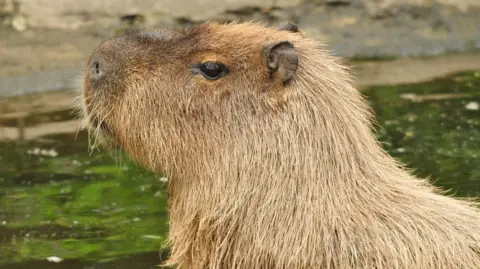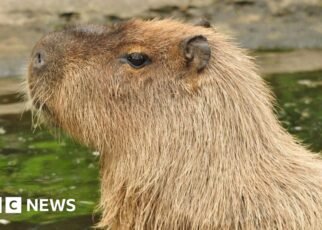 Hoo Zoo and Dinosaur World
Hoo Zoo and Dinosaur WorldThe search for Cinnamon the escaped capybara is to resume after efforts to find her were paused over fears she could move on to Ministry of Defence (MoD) land.
She escaped from her enclosure at Hoo Zoo in Telford, Shropshire, on 13 September and since then has been living in zoo-owned woodland outside the site’s perimeter.
Another attempt to capture the giant rodent will be made on Friday evening.
“The big issue that we face…the thicket that she’s in is literally impenetrable,” said Will Dorrell, the zoo’s owner.
“It’s probably about 100 square metres in total and it is 6ft high brambles that she can very easily slip under.
“If she sits right in the middle of there, practically speaking, the only way of getting to her is by chopping everything down, which is not a realistic way and also could scare her or cause injury to her.”
 Hoo Zoo and Dinosaur World
Hoo Zoo and Dinosaur WorldThe zoo had already put down traps on tracks that Cinnamon had regularly left in the area.
However the fugitive rodent refused to take the bait.
“She actually has now made tracks around the side of the cages,” said Mr Dorrell.
“So she’s obviously seen them and decided she’s walking around them rather than walking through them.”
The woodland sits next to a MoD site and the zoo said they were concerned if she moved there, they might not be able to capture her.
Cinnamon’s family ‘off colour’
Cinnamon’s story has captured international attention, with media descending on the zoo and interview requests from as far away as the USA.
“It’s been a manic few days,” Mr Dorrell said.
“Last night I had about three hours of sleep, it’s been a bit of a long one.”
He added that although Cinnamon’s family were not distressed, they have been “off colour”.
“They’re spending quite a lot of time down near the gate that she escaped through,” Mr Dorrell said.
“Either they’ve recognised that they could also get out if they’re quick enough or they’re waiting for her to come back.”
Are capybaras an endangered species?
- Capybara are not an endangered species, according to The International Union for Conservation of Nature
- They are sometimes referred to as the giant guinea pig and they are the world’s largest rodent species
- Capybaras are native to South America and can grow to more than 1m (3ft) in length
- They are highly social animals and are usually found living in small herds on grassland, in tropical rainforest, as well as in wetlands across the continent
- They eat grass and aquatic plants and often eat their own droppings as digesting their food a second time helps to absorb nutrients
- Capybaras have webbed feet and their eyes, ears and nostrils are on top of their heads, allowing them to stay mostly submerged in water for long periods of time
(Source: World Wildlife Fund)




